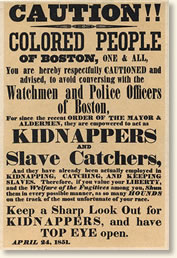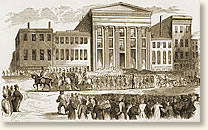|
Return of a Fugitive Slave, 1854
Anthony Burns was a slave in his early twenties
who had been hired out by his master to a man in Richmond. His duties often took
him to the city docks where the freighters busily filling their holds with cargo
for delivery to distant ports provided a chance of escape. In early February
1854 Anthony, aided by a friendly sailor, stowed away on one of these ships.
The next day the slave, hidden in a small space in the bowels of the vessel,
sailed down river on a journey to a new life. Four weeks later the ship docked
in Boston and Anthony stepped ashore a free man. Or so he thought.
 | A Boston poster warns
of slave catchers,
April 1851 |
|
Unfortunately for Anthony, four years earlier Congress had passed the Fugitive Slave Act as part of the Compromise of 1850 that balanced the admission of new Slave and Free States to the Union. The Act required all US citizens to assist in returning to their owners escaped slaves who sought freedom in a Free State. Not long after his arrival, Anthony's owner was in Boston looking for him as were a number of slave hunters motivated by the promise of a reward for the slave's capture.
On May 24, 1854, after only three months of freedom, Anthony was sighted by a slave hunter, immediately imprisoned and taken before a court where his fate would be decided. His incarceration sparked outrage among the citizenry of Boston. This seething anger came to a head three nights later when an angry mob stormed the Court House where he was being held in an attempt to free the hapless prisoner. They were unsuccessful. Efforts were then made to secure the slave's freedom by buying him from his master. But this too was unsuccessful.
Nine days after Anthony's capture the court rendered its verdict. He would be
taken back to Virginia and a life of slavery the next day. The authorities now had a
problem. The prisoner would have to be transported to his ship through the
streets of Boston where an angry crowd might attempt his release. The heavy
guard that had defended the Court House ever since the attempt by the mob to
storm the building was beefed up. On the morning of his transfer the streets
surrounding the Court House were filled with a near-riotous multitude estimated
at 50,000 shouting "Shame!" The atmosphere was tense as the procession wound
its way to the harbor and the prisoner finally secured on the ship on which
he would sail back into bondage.
"...a detachment of infantry charged upon the dense mass, at a run, with fixed bayonets."
Charles Steven's was a witness to the return of the fugitive slave to bondage and wrote a book describing the incident shortly after it occurred. We join his story as the procession to the harbor assembles outside the Court House:
"About eleven o'clock, the troops on the Common received orders to move down into Court and State streets. Each man had been supplied with eleven rounds of powder and ball, and, before moving, they proceeded to load in the presence of the assembled spectators. Then, without music, they marched down through the above-named streets, dropping off detachments at the several side streets, until the whole were posted.
Meanwhile, the Marshal had been making his own preparations. One hundred and twenty-five men were sworn in as specials. Some of these were tide-waiters, truckmen, and other dependents upon the Custom House; all were taken from the least reputable portion of the citizens of Boston. No better could be obtained.
These specials were assembled in the Court House, and armed with cutlasses, pistols, and billies. They were then placed under the command of one Peter T. Dunbar, a Custom House truckman, who led them into an upper hall of the building, and there drilled them in marching and other exercises before the door of Burns's cell. Besides these, the Marshal had assembled five companies of United States troops, numbering one hundred and forty men; and, to complete his array, a brass cannon had been transported from the Navy Yard in Charlestown, at early dawn, and planted in the Square.
At eleven o'clock, Court Square presented a spectacle that became indelibly engraved upon the memories of men. The people had been swept out of the Square, and stood crowded together in Court street, presenting to the eye a solid rampart of living beings. At the eastern door of the Court House, stood the cannon, loaded, and with its mouth pointed full upon the compact mass. By its side stood the officer commanding the detachment of United States troops, gazing with steady composure in the same direction. It was the first time that the armed power of the United States had ever been arrayed against the people of Massachusetts. Men who witnessed the sight, and reflected upon its cause, were made painfully to recognize the fact, before unfelt, that they were the subjects of two governments.
...Burns remained in the courtroom awaiting the hour of his departure. The retainers
of the Marshal crowded around him with attempts at consolation. His guards
especially endeavored to cheer his spirits. They gave him four dollars; they
assured him that it was their intention to purchase his freedom; they had made
arrangements with his owner, they said, and had already obtained four hundred
dollars toward the object. To all these professions and promises Burns paid
little heed; they came from the same men who had captured him.
At length, Deputy Marshal Riley entered the room and ordered him to be handcuffed. Burns earnestly remonstrated against the indignity; he gave assurances that he would pass through the streets quietly, if allowed to go unshackled, otherwise, he threatened to make every demonstration of violence in his power. Butman (the slave-hunter who had captured Burns) thereupon left the room, and sought the Marshal's permission to dispense with the instruments of disgrace; and, in spite of counsel to the contrary from some cowardly adviser who stood by, the request was granted. The slavery into which Burns was returning was an evil which he had borne from the cradle, but the iron fetters were symbols of disgrace which his unbroken spirit was not prepared to endure.
At length, about two o'clock, the column was formed in the Square. First came a detachment of United States Artillery, followed by a platoon of United States Marines. After these followed the armed civil posse of the Marshal, to which succeeded two platoons of Marines. The cannon, guarded by another platoon of Marines, brought up the rear. When this arrangement was completed, Burns, accompanied by a officer on each side with arms interlocked, was conducted from his prison through a passage lined with soldiers, and placed in the centre of the armed posse...
The route from the Court House to the wharf had by this time become thronged with a countless multitude. It seemed as if the whole population of the city had been concentrated upon this narrow space. In vain the military and police had attempted to clear the streets; the carriage-way alone was kept vacant. On the sidewalks in Court and State streets, every available spot was occupied; all the passages, windows, and balconies, from basement to attic, overflowed with gazers, while the roofs of the buildings were black with human beings. It was computed that not less than fifty thousand people had gathered to witness the spectacle.
 | The procession leaves the Court House
from a contemporary illustration |
|
At different points along the route, were displayed symbols significant of the prevailing sentiment. A distinguished member of the Suffolk Bar, whose office was directly opposite the courtroom, and who was, at the time, commander of the Ancient and Honorable Artillery, draped his windows in mourning. The example was quickly followed by others. From a window opposite the Old State House, was suspended a black coffin, upon which was the legend, The Funeral of Liberty. At a point farther on toward the wharf, a venerable merchant had caused a rope to be stretched from his own warehouse across State Street to an opposite point, and the American flag, draped in mourning, to be suspended therefrom with the union down. On looking forth from his window some time after, he saw a man intent on casting a cord over the rope, for the purpose of tearing down the flag.
'Rascal!' shouted the old man, as he sallied forth with his long white hair streaming behind, 'desist, or I'll prosecute you.'
'I am an American,' answered the other, 'and am not going to see the flag of. my country disgraced.'
'I too am an American, and a native of this city,' retorted the State street merchant, 'and I declare that my country is eternally disgraced by this day's proceedings. That flag hangs there by my orders: touch it at your peril.' The flag remained, until the transaction of which, in its dishonor, it was a fit emblem, was fully ended.
Along this Via Dolorosa, with its cloud of witnesses, the column now began to move. No music enlivened its march; the dull tramp of the soldiers on the rocky pavements, and the groans and hisses of the bystanders, were the only sounds...
Opposite the Custom House, the column turned at a right angle into another street. This cross movement suddenly checked the long line of spectators which had been pressing down, State street, parallel with the other body; but the rear portion, not understanding the nature of the obstruction, continued to press forward, and forced the front from the sidewalk into the middle of the Street. To the chafed and watchful military, this movement wore the aspect of an assault on the cortege; instantly some Lancers, stationed near, rode their horses furiously at the surging crowd, and hacked with their sabres upon the defenceless heads within their reach. Immediately after, a detachment of infantry charged upon the dense mass, at a run, with fixed bayonets. Some were pitched headlong down the cellar-ways, some were forced into the passages, and up flights of stairs, and others were overthrown upon the pavement, bruised and wounded.
While this was passing, the procession moved on and reached the wharf...
At the end of the wharf lay a small steamer which had been chartered by the United States Government. On board this vessel Burns was conducted by the Marshal, and immediately withdrawn from the sight of the gazing thousands into the cabin below. The United States troops followed and, after an hour's delay, the cannon was also shipped. At twenty minutes past three, o'clock, the steamer left the wharf, and went down the harbor."
References:
Charles Stevens' account appears in: Stevens, Charles Emery, Anthony Burns, a history (1856, republished 1969); Curti, Merle, The Growth of American Thought (1964); McPherson, James, M., Battle Cry of Freedom: The Civil War Era (1988).
How To Cite This Article:
"Return of a Fugitive Slave, 1854", EyeWitness to History, www.eyewitnesstohistory.com (2005).
|






